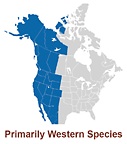A practical guide to bird watching in Sonoma County, California
(Unless otherwise indicated, all phone numbers are in the 707 area code)
A practical guide to bird watching in Sonoma County, California
(Unless otherwise indicated, all phone numbers are in the 707 area code)


Fairly common in Sonoma County along the Pacific coast in the winter and during the spring and autumn migration. Mostly absent in June and July. Prefers rocky, wave-swept beaches but may forage anywhere in kelp debris and on tidal mud flats. Often seen in small groups resting at high tide on pilings and docks. Fairly reliably present at Porto Bodega and elsewhere around Bodega Bay.
We usually see Black Turnstone in winter (non-breeding) plumage in Sonoma County when the head, breast, and back are fairly uniformly dark (mostly a very dark umber rather than true black) and the belly and vent are white (photo below). In breeding plumage, acquires a white patch at the lores, a white eyebrow, and white streakiness on the sides of the neck and upper breast (photo above), although there is usually a hint of white behind the eye even in non-breeding plumage. Juvenile is similar to the winter adult. The legs are a dark orange-brown in all plumages, but may appear black at a distance or if covered with sand, mud, or other material. Long median coverts hanging over the sides give the bird a typical disheveled look with the blackish feathers creating an irregular "fringe" that contrasts with the white belly. In flight, dramatic black and white pattern (white on back; white at base of tail, which is tipped with black; white at "shoulder"; and with a white stripe along the entirety of the outstretched wing) is distinctive, but Ruddy Turnstone (Arenaria interpres) is similarly marked. Willet (Tringa semipalmata) also shows black and white in the wings in flight, but Willet is a much larger, long-legged, mostly grey bird without the black and white tail pattern. A number of other shorebirds have fairly bold dark and light patterns in flight. It may be useful to study these before heading out. The newest Peterson guide at time of writing (4th edition, see below) has a good section comparing shorebirds in flight (pp. 154-161).
Often seen with and most likely to be confused with Ruddy Turnstone. The two species look quite different in breeding plumage when Ruddy Turnstone--as its name suggests--has large patches of a ruddy red-brown in the back and wings; a white head and breast but with a black pattern on the breast that makes it look like it's wearing a bib; and orange legs. If the legs are clean and can be seen well, the color difference is enough to distinguish the two birds in any plumage, but especially in non-breeding plumage, when Ruddy Turnstone loses much of its ruddiness and its head darkens.
Further reading:
Bolander and Parmeter, Birds of Sonoma County California, rev. ed., 2000, p. 54
Brinkley, National Wildlife Federation Field Guide to Birds of North America, 2007, p. 225
Dunn and Alderfer, eds., National Geographic Field Guide to the Birds of North America, 5th ed., 2006, p. 176
Dunn and Alderfer, eds., National Geographic Field Guide to the Birds of North America, 6th ed., 2011, p. 188
Ehrlich, Dobkin, and Wheye, The Birder's Handbook, paperback edition, 1988, p. 140
Fix and Bezener, Birds of Northern California, 2000, p. 153
Floyd, Smithsonian Field Guide to the Birds of North America, 2008, p. 166
Kaufman, Field Guide to Birds of North America, 2000, p. 180
Kaufman, Field Guide to Advanced Birding, 2011, p. 114
Parmeter and Wight, Birds of Sonoma County California, Update (2000-2010), 2012, p. 30
Paulson, Shorebirds of North America: The Photographic Guide, 2005, pp. 198-200
Peterson, Field Guide to Birds of Western North America, 4th ed., 2010, p. 140, 154
Peterson, Western Birds, 3rd ed., 1990, p. 142
Sibley, Field Guide to Birds of Western North America,1st ed., 2003, p. 161
Vuilleumier, American Museum of Natural History, Birds of North America: Western Region, 2011, p. 150
Voice: Cornell Lab of Ornithology: All About Birds--Black Turnstone
© Colin Talcroft, 2009, 2010, 2011, 2012, 2013
Unless noted, all photos by the author. If you would like to use one of my images, please ask for permission for non-commercial use with proper credit or commercial use with proper compensation.
Black Turnstone, breeding plumage, Campbell Cove, Bodega Bay, April 23, 2012
For comparison: Ruddy Turnstones--Note browner color, with ruddiness on the back, white in face, bright orange legs. Porto Bodega, Bodega Bay, September 25, 2012


Black Turnstone in flight showing wing, back, and tail pattern Campbell Cove, Bodega Bay, April 23, 2012
For comparison: Willet showing wing pattern
Bodega Bay, July 6, 2011

Black Turnstone in non-breeding plumage. Note mostly dark head and breast
Campbell Cove, Bodega Bay, September 8, 2010
Black Turnstone
Arenaria melanocephala
1990-2013 Sonoma County data. Graph provided by eBird (www.ebird.org), generated May 30, 2013
EBird reported occurrence in Sonoma County

